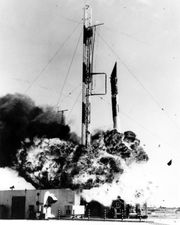On November 2, 1957, the Soviet Union successfully launched Sputnik 2 into space. Aboard was Laika, a dog that survived the launch into space and was kept alive for one hundred hours. This proved, once again, that the USSR's space technology was vastly superior to that of the United States.
Vanguard was scheduled to be launched early the next year, 1958. However, the USSR's success caused the US to advance the launch date to December 4 of 1957. The launch had to be delayed for two days, but finally, on December 6, the engine was ignited. The rocket began to lift off slowly, but suddenly it toppled over and exploded on the launch pad.
Because of the USSR's two major triumphs and the Vanguard disaster, Eisenhower's administration decided that, to save face, Warner von Braun's team would have to be put in charge of launching a satellite for the US. On January 29, 1958, von Braun's team launched the Explorer 1 satellite on a Juno rocket, a modified version of the Jupiter C. The launch was successful.
The United States' launch of a satellite was a triumph for the United States because it proved that the USSR had not left the US far behind in space technology. However, when the US decided to utilize a rocket used for ballistic missile development to save face after the USSR's accomplishments, it made its entrance into the tragedy of the space race.

